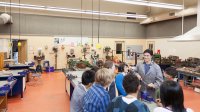Makerspaces and Equal Access to Learning
Makerspaces can democratize learning, create a culture of participation, and facilitate differentiated instruction.
Makerspaces are unique and attractive in today's schools. They offer a complete learning environment that allows limitless opportunities. However, we need to hear more discussion about how these spaces can be used by all learning groups. This includes students with special needs as well as English language learners. Students who have unique learning needs thrive in a makerspace because it allows them to express themselves without fear of failure.
By providing equity and access, makerspaces are inviting and inclusive environments. Based on our work and experiences, we'd like to offer five ways in which makerspaces can provide learning for all.
1. Democratize Learning
Great makerspaces democratize learning. They make materials, supplies, and concepts available and accessible to all learners. By properly planning your makerspace, you can build an environment that levels the academic playing field for your students.
One important attribute of this inclusive learning space is that it encourages tinkering, play, and open-ended exploration for everyone. When you assess the existing curricula, programs, and offerings within your school community, it's possible to pull out concepts that are frequently taught to a select number of students and make them available and accessible to anyone who's interested.
2. Low Barrier of Entry
When a makerspace aligns its activities with the principles of creating a participatory culture, it can effectively meet all of our learners' needs. Most useful to consider is the idea of having a low barrier to artistic expression and civic engagement. This low barrier of entry into the makerspace activities will ensure that any of your students—regardless of their academic proficiency level or even whether English is their primary language—can begin making with very little or no teacher facilitation.
Makerspaces offering open access to materials, supplies, and easy-to-start activities will guarantee successful and independent learners while limiting frustration. Despite this low barrier of entry, it's also possible to ensure that students find challenges here with the opportunity to take their learning as far as they choose—a student-driven learning environment.
3. Visual Cues
An effective strategy to ensure that your makerspace helps to meet all of your learners' needs is using visual cues to communicate and give necessary directions. This strategy is especially beneficial for learners who have difficulty following complicated directions or remembering instructions for extended periods of time. Effective visual cues will support your learners in becoming independent thinkers and problem solvers, even if reading skills or language stand in their way under other circumstances.
When creating signage and displays, it's important to give students enough information to motivate and inspire them, getting them started without giving them too much information, which might otherwise take away their opportunity to discover things through their making. These discoveries are sure to bolster their self-confidence, as well as increase their willingness to take risks.
4. Themes
Thematically planned makerspaces provide opportunities to meet the needs of all learners. Supporting themes in varied ways will allow you to address your students' diverse learning styles by providing a suite of multimodal materials and resources to meet better their needs. Students with learning differences—and all learners, really—benefit from utilizing as many of their sensory modalities as possible.
Themes in a makerspace can also kickstart making and creativity by inspiring students and sparking ideas. They are helpful for students who might experience frustration and have trouble working with zero guidelines in place.
5. Differentiation
There are many ways to differentiate effectively in a makerspace, such as providing the materials, activities, and supplies to meet the needs of mixed-ability learners. Another strategy is to consider differentiation as you plan the physical setup of your space. Centers or workstations encourage students to collaborate with their peers. The unique learning environment of a makerspace invites students of varying abilities to work together, creating a community of learners. Because they feel equal to their peers, English-language learners, as well as students with special needs, feel welcomed in these types of spaces.
Another way to differentiate in a makerspace is by empowering students to follow their own process for making and creating, rather than attaching a prescriptive process. Your makerspace might be the only space in your school in which learners have the opportunity to take control of their learning in this way. This type of flexible, self-directed learning will empower as well as enhance all learners' unique learning abilities. A differentiated makerspace can allow students of all abilities to participate, experience success, and ultimately flourish.
Along with the traditional methods, consider personalizing a student's learning path through the use of open educational resources (OER). Because they are free, OER provide both teachers and learners with equal access to high-quality content, which can be modified and customized to meet individual needs. Students can also seek out and shape their own resources, enabling them to be able to direct their own learning.
